

Restaurants. Pre-Intermediate Level: Restaurant Role Cards. English Language Practice: Ordering at a Restaurant. Knowing how to order food at a restaurant is an important task for any beginner-level English learner. Here are two short dialogues to help you learn common questions and answers used at restaurants. Dining at a Restaurant Alone This dialogue includes most of the basic questions you'll need to know when going to a restaurant alone. Pie Restaurant. Pre-Listening Exercise Finding good restaurants usually isn’t a problem for language students; ordering at one can be if you don’t know appropriate language expressions.
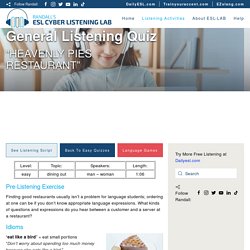
What kinds of questions and expressions do you hear between a customer and a server at a restaurant? Writing - Intermediate B1. Reviewed yesterday Great mains, pity about the chips Came for lunch with my sister.
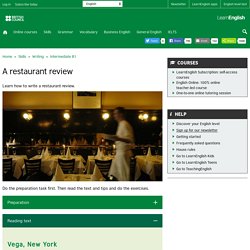
We loved our Thai-style mains which were amazing with lots of flavour, very impressive for a vegetarian restaurant. But the service was below average and the chips were too terrible to finish. When we arrived at 1.40, we had to wait 20 minutes while they got our table ready. How to Order at a Restaurant: US vs UK. Do you ask for the bill or the check?
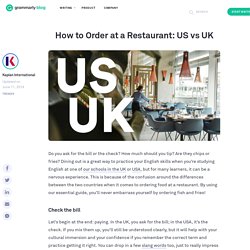
How much should you tip? Are they chips or fries? Restaurant Lesson for ESL Students. You are here: EL Civics > Restaurants > Page 2 > Page 3 People go to restaurants to buy food that is already prepared.
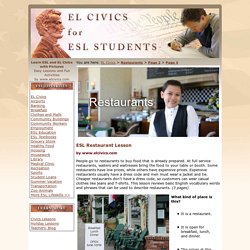
At full service restaurants, waiters and waitresses bring the food to your table or booth. Breaking News English ESL Lesson Plan on Eating Insects. 1.

TRUE / FALSE: Read the headline. Guess if a-h below are true (T) or false (F). 2. SYNONYM MATCH: Match the following synonyms from the article. 3. LISTENING - Guess the answers. LISTENING – Listen and fill in the gaps A new United Nations report says that (1) _____________________. Many cultures already (7) _____________________ diet. From. A restaurant menu. At the restaurant. Restaurant Vocabulary.
English exercises: at the Restaurant. Pig or Pork? Cow or Beef? Now, Words and Their Stories from VOA Learning English.
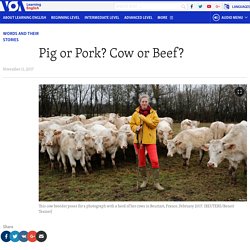
On this program we often talk about the origins of words and expressions that we use in American English. We also talk about how we use them in everyday conversations. Today we talk about animals--and animals we eat. In English, these two categories often have different names. Pigs turn into pork. But why do we call these animals different names when we prepare them for a meal? The answer is the Norman Conquest of Britain in 1066. And many others related to food. When animals were in the stable or on the farm, they kept their Old English names: pig, cow, sheep and calf. On several websites, word experts claim that this change shows a class difference between the Anglo-Saxons and the French in Britain at the time of the conquest. Because the lower-class Anglo-Saxons were the hunters, they used the Old English names for animals.
However, the words “deer" and "venison," however, are a bit more complicated. What about fish? At a Restaurant - Beginning Level English. Fun Breakfast Facts. My favourite meal. Pre-Intermediate Reading. Here are four people talking about eating out.
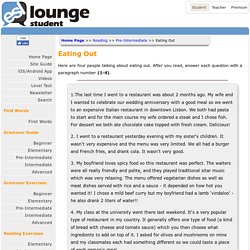
After you read, answer each question with a paragraph number (1-4). 1.The last time I went to a restaurant was about 2 months ago. My wife and I wanted to celebrate our wedding anniversary with a good meal so we went to an expensive Italian restaurant in downtown Lisbon. We both had pasta to start and for the main course my wife ordered a steak and I chose fish.
For dessert we both ate chocolate cake topped with fresh cream. Unit 3_Food around the world. The world's weirdest food. Food issues. Submitted 5 years 3 months ago by admin.
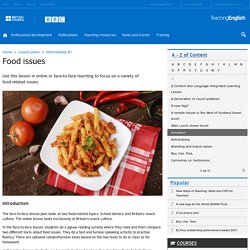
This lesson plan for teachers of teenage students at level B1 focuses on food related topics. Students will develop their reading and fluency. Introduction This lesson plan has been developed to support the IATEFL Global Issues SIG and their October event focusing on Food issues. The lesson looks at two food-related topics: School dinners and Britain's Snack culture. Cooking in Britain Today. Introduction This lesson consists of a series of activities to help students talk about food and cooking.
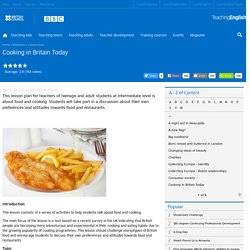
The main focus of the lesson is a text based on a recent survey in the UK indicating that British people are becoming more adventurous and experimental in their cooking and eating habits due to the growing popularity of cooking programmes. This lesson should challenge stereotypes of British food and encourage students to discuss their own preferences and attitudes towards food and restaurants.